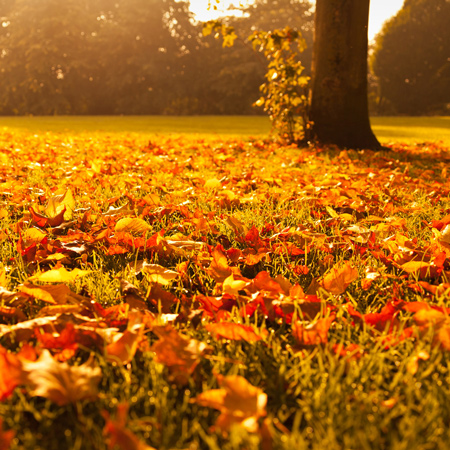The Eden Project's Autumn Gardening Tips
Autumn and winter is a truly spectacular time of the year. The leaves on the trees start to turn into a multi-coloured feast for the eyes, with golden browns and vibrant oranges adorning branches and frost starts to lightly touch the most delicate leaves leaving a beautiful silver sheen. And although it might seem like our gardens and wildlife are starting to wind down in preparation for the cooler temperatures, there’s still plenty of new growth and time for us to get creative in our gardens despite the drop in temperature.

With that in mind, we’ve teamed up with our sustainability and environmental partner, the Eden Project, to share some advice on living more sustainably by growing some of your own veg and looking at the ways we can care for our gardens from September through to December. Here, Florence Mansbridge, horticulturist at the Eden Project, shares her advice.
September
Gardening is all about continuity and that means autumn and winter are still great times of the year to sow things in the garden and grow some delicious salad leaves or leafy winter vegetables.
Chicory, rocket, Swiss chard, spinach, endives, pak choi and frilly mustard are all great things to plant in the month of September and they should be ready to harvest after about 8 weeks, providing you with some lovely, fresh veg to munch on in November! Indeed, growing veg at home means there’s no big carbon footprint associated with it, plus there’s no packaging or plastic used to protect it during transit to the supermarket and it can also help to reduce food waste, so it’s a win all round!
If you fancy growing some yourself, you’ll just need a few simple items, many of which can be found by reusing or recycling household items:
- Plastic recycled plant trays to pop your freshly sown plants in (sometimes your local garden centre will have some empty ones you can take for free if you ask them nicely)
- The cardboard cylinder from a finished toilet roll to plant and grow your seedlings in and use as a pot (a great way to recycle these!)
- Plant labels – you can make these by reusing any butter, margarine or yoghurt pots you might have. Simply cut them into the desired size and shape and write on them with a marker pen (make sure you recycle any plastic you don’t use). Alternatively, you can buy ready-made labels made from recycled materials
- Compost and soil
- Winter vegetable seeds of your choice
Once you have everything you need, pop your recycled toilet roll pot in the plant tray and fill with compost. Press your finger into the soil to make a dent where you can place a few seeds. Ideally you want to pop a couple of seeds in each makeshift pot. If you find that a couple of plants start to grow at the same time, then you can always thin them out.
Next, gently water your seeds with a fine spray and pop them on a sunny windowsill and leave them to grow until they’re about an inch high. To acclimatise them to the outside, start by putting them out during the day and bringing them in at night for a couple of days. After that they should be ready for planting in your vegetable patch. If you have problems with slugs and snails it is worth growing them on a bit longer until they are more resilient.
October
October is the prime time to care for your lawn and make sure it’s in tip top condition, ready for the cooler weather.

Make sure you gather all fallen leaves from your lawn and pop them into a recycled sack or box. You can leave them in here until the spring to create a lovely leaf mulch to use later in the year – perfect for providing extra nutrients and organic matter for your plants when the hotter weather kicks in.
It’s also the ideal time to consider mowing your lawn for the last time before the Spring.
Make sure you don’t mow it too short though, it’s always best to leave a little bit of height to help sustain it through the winter. Allow some areas of long grass to provide overwinter shelter for wildlife.
October is also a great time to give your garden a general tidy up and prepare it for the colder weather. Trimming your hedges so that you have neat crisp lines for the winter will give your garden a tidy appearance and set your bushes up to thrive come the summer. Be mindful to leave some undisturbed parts of the garden, piles of leaves, twigs and logs are ideal places for hedgehogs, frogs and toads to hibernate as well as providing habitat for insects. Avoid cutting back mature ivy as this also provides shelter for hibernating insects and its late autumn flowers provide substance for late flying pollinators.
You should also make sure you bring terracotta pots indoors so the frost doesn’t cause them to split, crack or chip, and make sure you cover wooden garden furniture up or pop it in storage so that it will last to see many more summers!
November
If you planted some vegetables in September now is the time to reap your rewards and harvest your produce to use in some delicious winter dishes! Be sure not to leave your veg patch bare though. Add a layer of mulch to it as this will stop the heavy winter rain from washing away all the nutrients from the soil. You can also add mulch around your perennials to protect them from the winter cold and frost. Using mulches such as wood chip or green compost will increase the organic matter, moisture retention of the soil and help supress weeds in the spring.
What’s more, November is also a great time to plant deciduous trees, such as rowan which is a great choice for wildlife as their berries are the favourite fruit of some bird species such as song thrush, who will pay back by helping keep snails under control. Planting in the winter allows your shrubs to acclimatise to their surroundings, encouraging early and strong root growth in the spring.
December
December is the month of pruning! Fruit trees such as apple and pear trees are best pruned every winter to keep them producing plenty of fruiting wood and to avoid them getting too congested with old wood. Make sure to always use clean, sharp secateurs and loppers to avoid tears when making a cut, this will limit the risk of infection.
Keep an eye on your potted or protected plants too (such as those in a greenhouse or under a canopy). Watering them in the morning will allow the foliage to dry off before the colder temperatures of the night set in and the evening frost arrives.
Birds in your garden will appreciate a drinking station, particularly if natural supplies are frozen. It can be tricky to stop a bird bath from freezing but there are a few tricks that can be used such as a light ball floating in the water which will move around with the slightest breeze.
Finally, if you have a compost heap or bin, don’t forget to tend to it during the winter. The decomposition process will slow down as temperatures drop, but the microbes will need energy to do their job, so be sure to keep feeding them, keeping the layers of browns and greens equal. It’s worth chopping food scraps up smaller before adding them. If you don’t fancy making as many trips to the compost bin when it’s cold, it can be worthwhile having a compost bucket with a tight fitted lid in your kitchen or by the back door.
Hypnos is working in partnership with The Eden Project, focusing on sustainable education and action. We’ll be working closely with the Eden Project to educate employees, retailers, and customers on all matters of sustainability and the environment – something we’re incredibly passionate about as sustainable bed manufacturer that’s been carbon neutral for over a decade.
In addition, a charitable donation from the sale of each mattress from our new Origins Organic Collection will be made to the Eden Project to help combat the climate crisis, and create a wide range of community education, biodiversity, conservation and regeneration projects.
For more information about the Eden Project.

